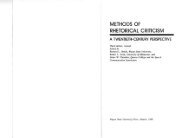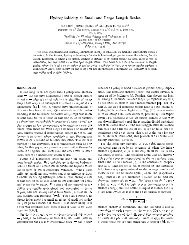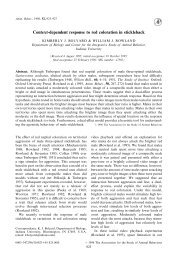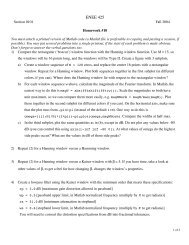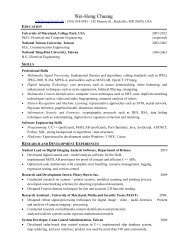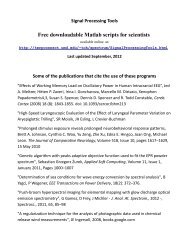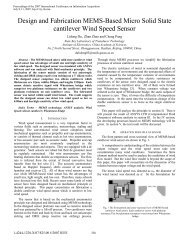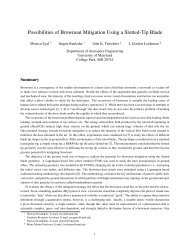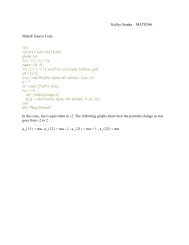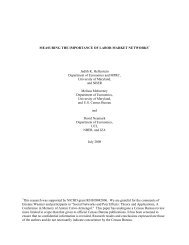Errors for Linear Systems When we solve a - TerpConnect
Errors for Linear Systems When we solve a - TerpConnect
Errors for Linear Systems When we solve a - TerpConnect
You also want an ePaper? Increase the reach of your titles
YUMPU automatically turns print PDFs into web optimized ePapers that Google loves.
On the other hand <strong>we</strong> have b = Ax ≤ A x. Combining this <strong>we</strong> obtain<br />
ˆx − x<br />
x ≤ A −1<br />
A <br />
<br />
<br />
<br />
ˆ <br />
<br />
b − b<br />
b .<br />
The number cond(A) := A A−1 is called condition number of the matrix A. It determines how much the relative<br />
error of the right hand side vector<br />
can be amplified. The condition number depends on the choice of the matrix norm: In<br />
general cond1(A) := A <br />
1 A−1 <br />
and cond∞(A) := A <br />
1 ∞ A−1 are different numbers.<br />
∞<br />
Example: In the above example <strong>we</strong> have<br />
<br />
cond∞(A) = A −1<br />
∞ A <br />
<br />
= 1.01<br />
∞ .99<br />
<br />
.99 ∞ <br />
25.25<br />
1.01 −24.75<br />
<br />
−24.75 ∞<br />
= 2 · 50 = 100<br />
25.25<br />
and there<strong>for</strong>e<br />
ˆx − x<br />
x<br />
<br />
<br />
<br />
≤ 100<br />
ˆ <br />
<br />
b − b<br />
b<br />
which is consistent with our results above (b and ˆ b <strong>we</strong>re chosen so that the worst possible error magnification occurs).<br />
The fact that the matrix A in our example has a large condition number is related to the fact that A is close to the singular<br />
matrix B =<br />
1 1<br />
1 1<br />
<br />
.<br />
The following result shows that<br />
Theorem: min<br />
B∈Rn×n A − B<br />
, B singular<br />
1<br />
cond(A) indicates how close A is to a singular matrix:<br />
A =<br />
1<br />
cond(A)<br />
Proof: (1) Lemma 1 shows: B singular implies A − B ≥ 1<br />
A −1 .<br />
(2) By the definition of A −1 there exist x, y ∈ R n such that x = A −1 y and A −1 = x<br />
y<br />
matrix E ∈ R n×n such that Ex = y and E = y<br />
x<br />
singular and A − B = E = 1<br />
A−1 . <br />
. By Lemma 2 there exists a<br />
. Then B := A − E satisfies Bx = Ax − Ex = y − y = 0, hence B is<br />
Example:<br />
<br />
1.01<br />
The matrix A =<br />
.99<br />
<br />
<br />
.99<br />
1<br />
is close to the singular matrix B =<br />
1.01<br />
1<br />
<br />
1<br />
so that<br />
1<br />
A−B∞ A =<br />
∞<br />
.02<br />
2 = .01.<br />
1<br />
By the theorem <strong>we</strong> have that 0.01 ≤ cond∞(A) or cond∞(A) ≥ 100. As <strong>we</strong> say above <strong>we</strong> have cond∞(A) = 100, i.e., the<br />
matrix B is really the closest singular matrix to the matrix A.<br />
<strong>When</strong> <strong>we</strong> <strong>solve</strong> a linear system Ax = b <strong>we</strong> have to store the entries of A and b in the computer, yielding a matrix  with<br />
rounded entries âij = fl(aij) and a rounded right hand side vector ˆb. If the original matrix A is singular then the linear<br />
system has no solution or infinitely many solutions, so that any computed solution is meaningless. How can <strong>we</strong> recognize<br />
this on a computer? Note that the matrix  which the computer uses may no longer be singular.<br />
1<br />
Ans<strong>we</strong>r: We should compute (or at least estimate) cond( Â). If cond(Â) < then <strong>we</strong> can guarantee that any matrix A<br />
εM<br />
which is rounded to  must be nonsingular: |âij<br />
<br />
<br />
− aij| ≤ εM |aij| implies  − A<br />
≤ εM A <strong>for</strong> the infinity or 1-norm.<br />
There<strong>for</strong>e Â−A<br />
 ≤<br />
εM<br />
1−εM ≈ εM<br />
1−εM<br />
and cond( Â) < εM<br />
nonsingular by the theorem.<br />
≈ 1<br />
εM<br />
Now <strong>we</strong> assume that <strong>we</strong> perturb both the right hand side vector b and the matrix A:<br />
Â−A<br />
imply<br />
 < 1 . Hence the matrix A must be<br />
cond( Â)



